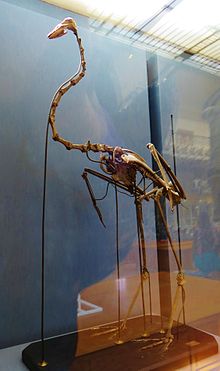| Palaelodus Temporal range: Possible Pleistocene records.
| |
|---|---|

| |
| Palaelodus ambiguus skeleton, Muséum national d'histoire naturelle, Paris | |
| Scientific classification | |
| Domain: | Eukaryota |
| Kingdom: | Animalia |
| Phylum: | Chordata |
| Class: | Aves |
| Order: | Phoenicopteriformes |
| Family: | †Palaelodidae |
| Genus: | †Palaelodus Milne-Edwards, 1863 |
| Species | |
| |
Palaelodus is an extinct genus of bird of the Palaelodidae family, distantly related to flamingos. They were slender birds with long, thin legs and a long neck resembling their modern relatives, but likely lived very different livestyles. They had straight, conical beaks not suited for filter feeding and legs showing some similarities to grebes. Their precise lifestyle is disputed, with researchers in the past suggesting they may have been divers, while more recent research suggests they may have used their stiff toes as paddles for swimming while feeding on insect larvae and snails. This behavior may have been key in later phoenicopteriforms developing filterfeeding bills. The genus includes between five and eight species and is found across Europe, Australia, New Zealand, Asia and possibly South America. However some argue that most of the taxa named from Europe simply represent differently sized individuals of one single species. Palaelodus was most abundant during the Late Oligocene to Middle Miocene periods, but isolated remains from Australia indicate that the genus, or at least a relative, survived until the Pleistocene.